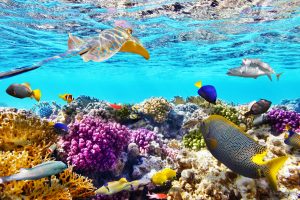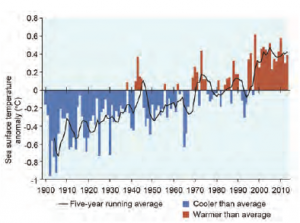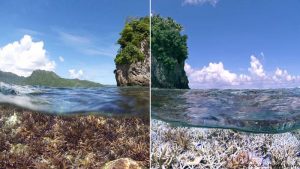The great barrier reef is a place that the vast majority of people have heard of, perhaps due to its incredible natural beauty, or maybe due

Source: Cruiseexperts.com
to the large host of species that it supports. Around 150 soft corals, 411 hard corals, 1625 bony fish, and about 1300 crustacean species call the great barrier reef their home, to name a few (Great barrier reef marine park authority, 2014). However, climate change is impacting the corals that make up the structure of the reef, with an estimated yearly loss of around 3,168km2 per year being the calculated loss between 1997 and 2003 alone (Bruno and Selig, 2007).
What are the Impacts of Climate Change?

Climate change has caused the sea surface temperatures to rise in recent years, as shown by figure 2 for the Coral Sea. In fact, the past 15 years has shown the hottest temperature averages all together, and this has many impacts on the animals and plants that live within the sea. This temperature rise leads to a phenomenon called coral bleaching. This is where corals lose their symbiotic algae, which live within the coral and provide it energy, which can lead to the coral’s death if the bleaching is prolonged or severe. The effects of this are easily seen, as the corals lose their colour, leaving just the white of the calcium skeleton (Brown, 1997).
As the temperature of the water increases, so does its ability to absorb CO2, leading to ocean acidification. The current level of atmospheric CO2 has been measured at 406.42 ppm, (NOAA, 2017), which is more than 100ppm above the maximum values seen over the last 740,000 years (Hoegh-Guldberg et al. 2007). 25% of the CO2 created by humans goes into the sea, leading to significant acidification. As the water turns more acidic, corals are unable to create their calcium skeletons as well, decreasing the rate at which they grow. The growth of corals has in fact decreased by 13.3% since 1990 (De’ath et al. 2009).
Climate change may lead to indirect damages to coral reefs too, with it leading to an increase in both the number and the intensity of storms, including hurricanes, in some regions (Hughes et al. 2003). This damages the corals, and the increase in frequency of the storms gives the reef less time to recover, killing some corals completely.
More than just the corals

The health of the corals also effect the many animals that inhabit the reef. The worst affected are the fish that require live corals as their homes, but fish that don’t depend on live coral are impacted too, as they are still dependent on the complexity of structure that the live coral bring (Pratchett et al. 2008).
With climate change growing more intense year by year, up to 60% reefs may be lost by 2030, and with them all the life which calls the reef home (Hughes et al, 2003). So, while it certainly remains a barrier reef, perhaps it’s not so great anymore…
[Words: 500]
References
- Brown B.E. 1997. ‘Coral bleaching: causes and consequences’ Coral reefs, 16, pp. 129-138
- Bruno J.F. and Selig E.R. 2007. ‘Regional Decline of Coral Cover in the Indo-Pacific: Timing, Extent, and Subregional Comparisons’ PLoS one 2(8), e711
- De’ath G., Lough J.M., Fabricus K.E. 2009. ‘Declining Coral Calcification on the Great Barrier Reef’ Science, 323, pp. 116-119
- Great Barrier Reef Marine Park Authority 2014, Great Barrier Reef Outlook Report 2014, GBRMPA, Townsville.
- Hoegh-Guldberg O. et al. 2007. ‘Coral Reefs Under Rapid Climate Change and Ocean Acidification’ Science, 318, pp. 1737-1742
- Hughes T.P. et al. 2003. ‘Climate Change, Human Impacts, and the Resilience of Coral Reefs’ Science, 301, pp. 929-933
- National Oceanic and Atmospheric Administration (NOAA), 2017. Trends in Atmospheric Carbon Dioxide. [Online] Available at: https://www.esrl.noaa.gov/gmd/ccgg/trends/index.html [Accessed: 21/03/2017]
- Pratchett M.S. et al. 2008. ‘Effects of climate-induced coral bleaching on coral-reed fishes – ecological and economic consequences. Oceanography and marine biology: an annual review, 46, pp. 251-296
Recent Comments